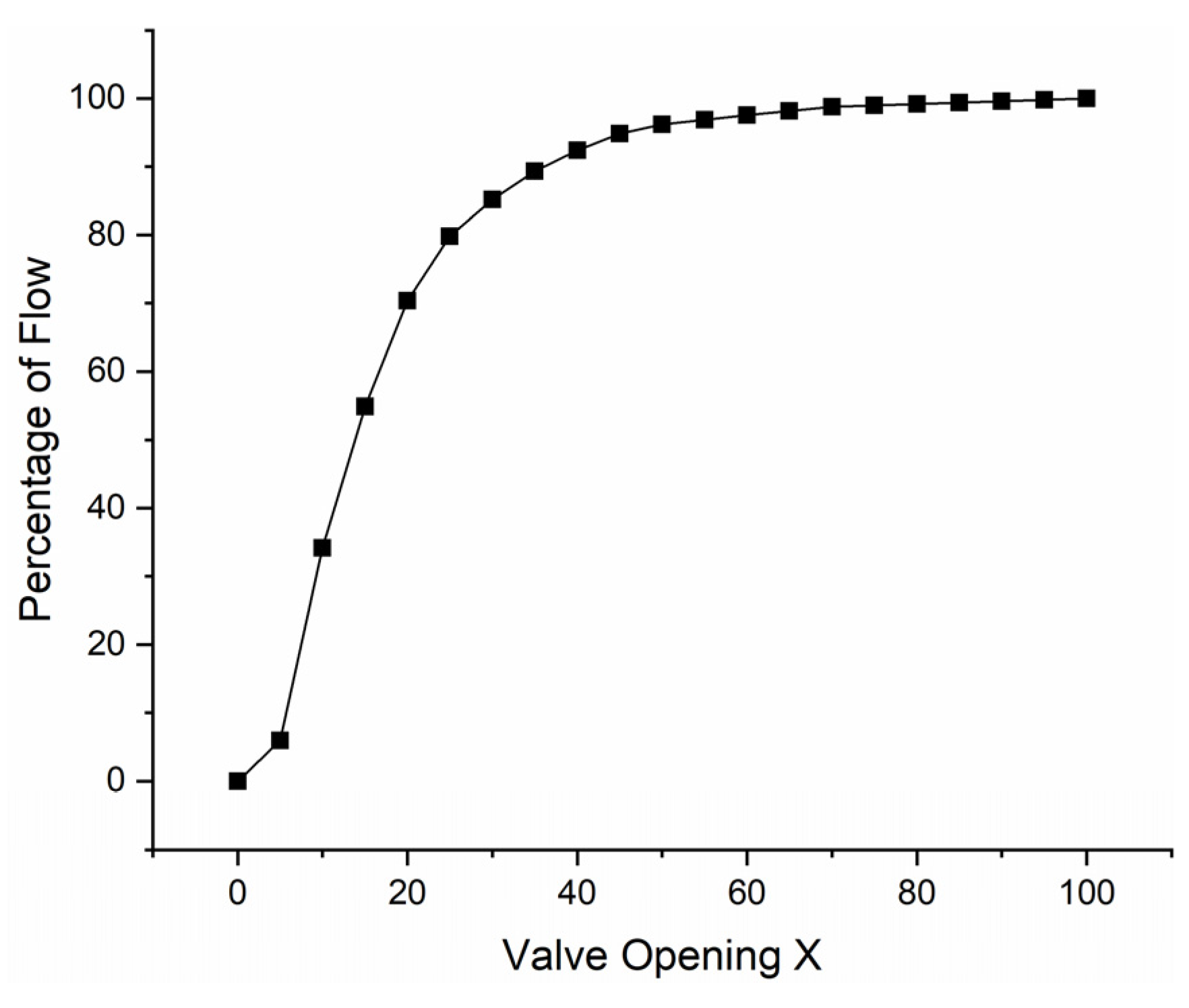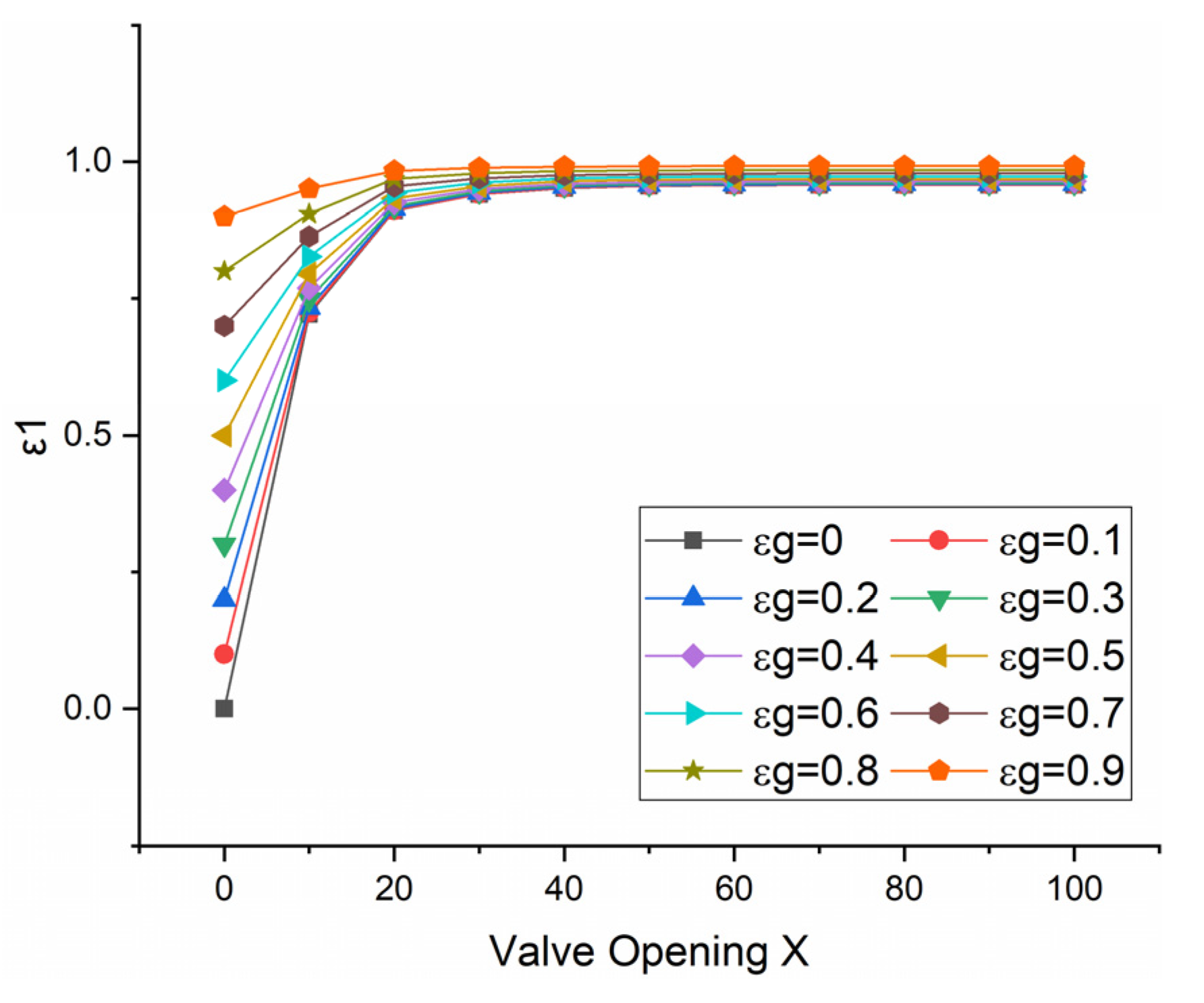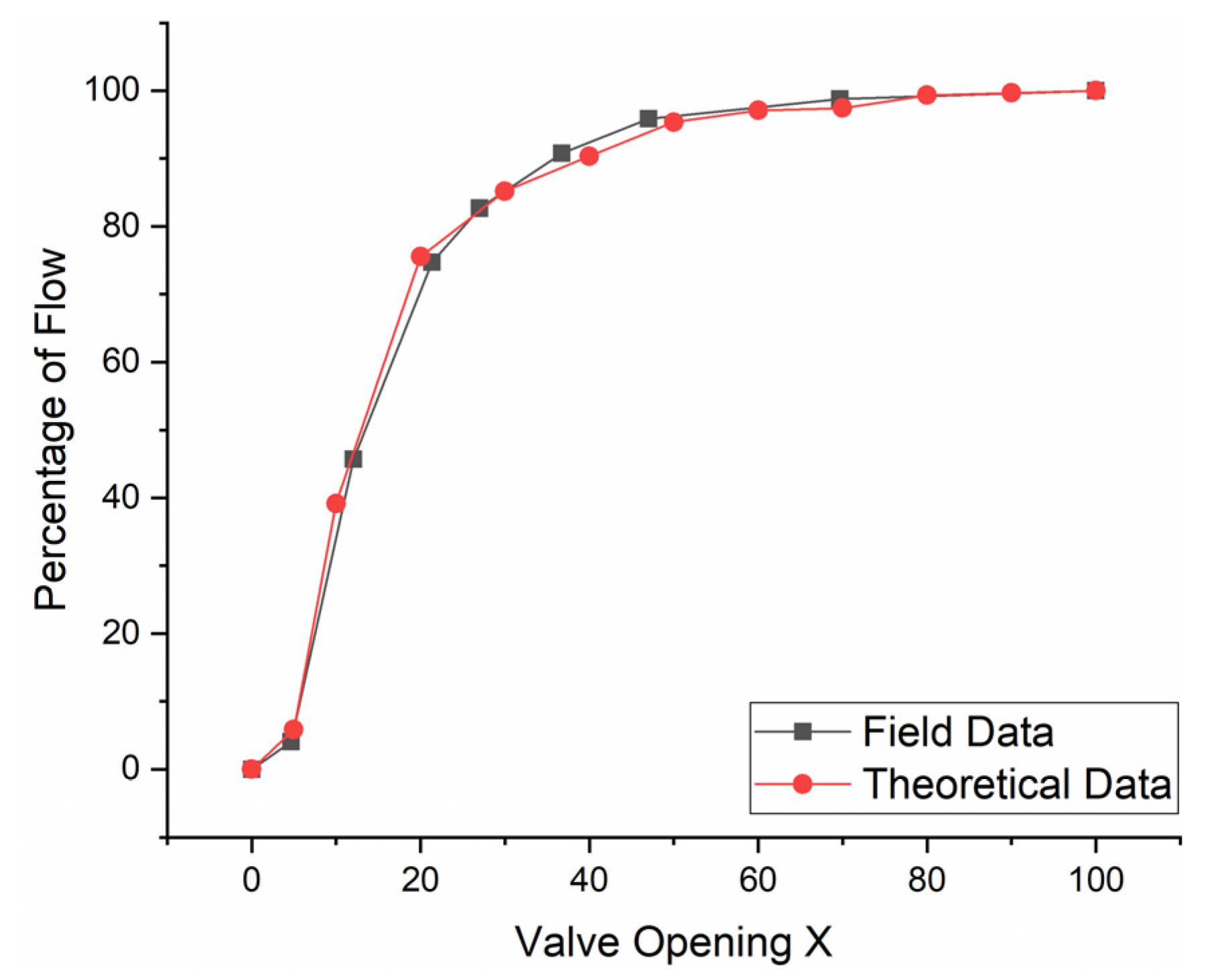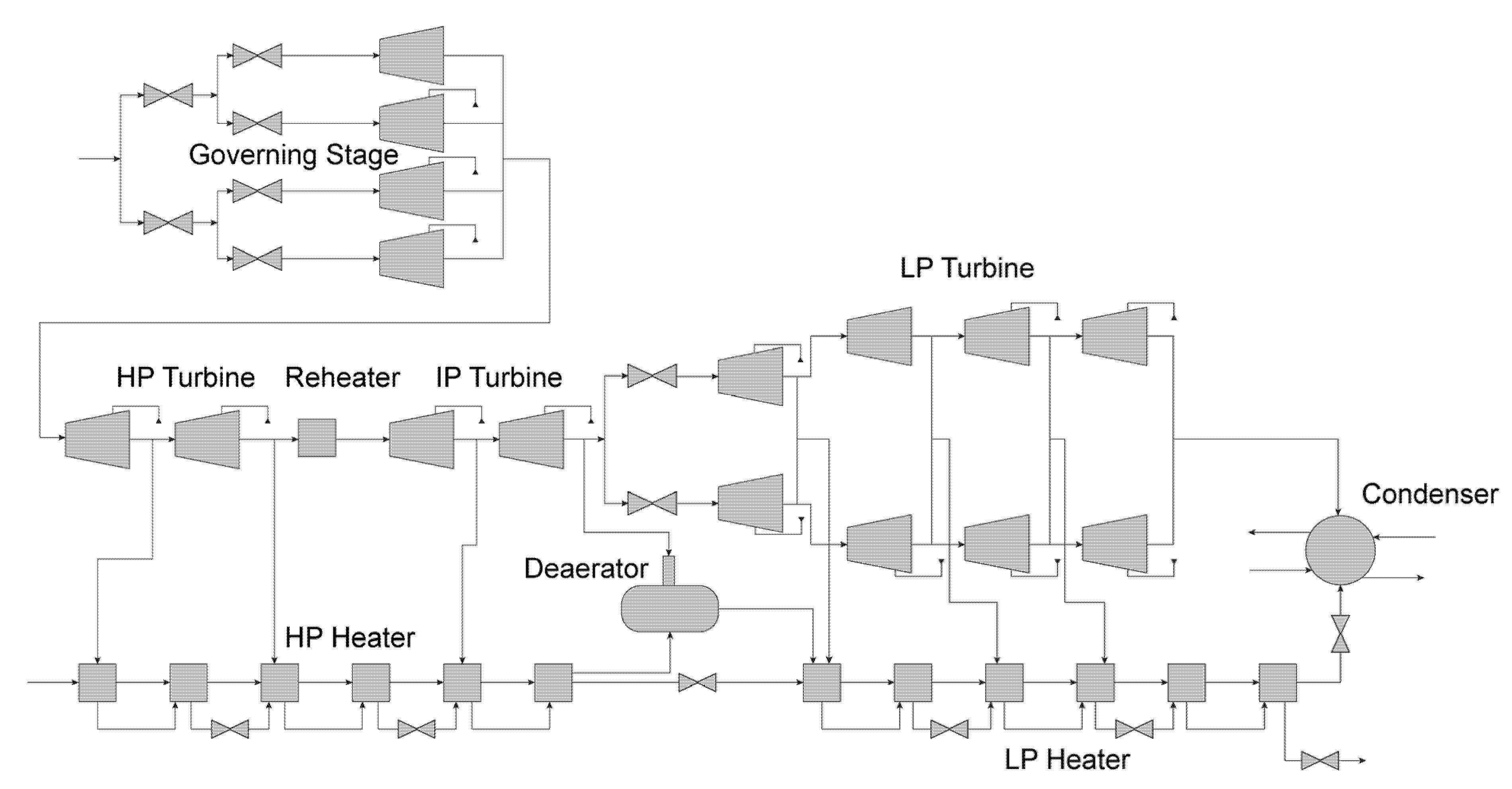Optimization of Steam Distribution Mode for Turbine Units Based on Governing Valve Characteristic Modeling
Abstract
:1. Introduction
2. Model and Analysis
2.1. Flow Characteristics of Governing Valve
2.2. Theoretical Model of Governing Valve
2.3. Overall Model of Turbine Unit
2.4. Steady-State Verification of the Turbine Model
2.5. Operation Mode Analysis
2.5.1. Comparison of Steam Distribution Modes
2.5.2. Impact of Main Steam Pressure on Unit Economics
3. Optimization Results and Discussion
3.1. Optimization Calculation of Steam Distribution Mode
3.2. Economic and Environmental Benefits Analysis
4. Conclusions
Author Contributions
Funding
Data Availability Statement
Conflicts of Interest
References
- Yang, L.; Zhang, L.; Wang, Y.; Huo, W.; Wang, D. Integrated energy scheduling using wind-storage cascade control strategy in dynamic peak regulation right. Electr. Power Syst. Res. 2022, 212, 108644. [Google Scholar] [CrossRef]
- Du, M.; Niu, Y.; Hu, B.; Zhou, G.; Luo, M.; Qi, X. Frequency regulation analysis of modern power systems using start-stop peak shaving and deep peak shaving under different wind power penetrations. Int. J. Electr. Power Energy Syst. 2021, 125, 106501. [Google Scholar] [CrossRef]
- Huang, K.; Luo, P.; Liu, P.; KIM, J.S.; Wang, Y.; Xu, W.; Li, H.; Gong, Y. Improving complementarity of a hybrid renewable energy system to meet load demand by using hydropower regulation ability. Energy 2022, 248, 123535. [Google Scholar] [CrossRef]
- Wang, P.; Yuan, W.; Su, C.; Wu, Y.; Lu, L.; Yan, D.; Wu, Z. Short-term optimal scheduling of cascade hydropower plants shaving peak load for multiple power grids. Renew. Energy 2022, 184, 68–79. [Google Scholar] [CrossRef]
- Ma, H.; Wang, H.; Yan, Z.; Yu, Q. Evaluating peak-regulation capability for power grid with various energy resources in Chinese urban regions via a pragmatic visualization method. Sustain. Cities Soc. 2022, 80, 103749. [Google Scholar] [CrossRef]
- Zhang, Y.; Liu, P.; Li, Z. Gas turbine off-design behavior modelling and operation windows analysis under different ambient conditions. Energy 2023, 262, 125348. [Google Scholar] [CrossRef]
- Wang, Z.; Duan, L.; Zhang, Z. Thermoeconomic cost analysis on operation strategies of gas turbine combined cycle under off-design conditions. Case Stud. Therm. Eng. 2021, 28, 101617. [Google Scholar] [CrossRef]
- Yazawa, K.; Koh, Y.R.; Shakouri, A. Optimization of thermoelectric topping combined steam turbine cycles for energy economy. Appl. Energy 2013, 109, 1–9. [Google Scholar] [CrossRef]
- Jastrzebska, A.; Hernández, A.M.; Nápoles, G.; Salgueiro, Y.; Vanhoof, K. Measuring wind turbine health using fuzzy-concept-based drifting models. Renew. Energy 2022, 190, 730–740. [Google Scholar] [CrossRef]
- Kiaee, M.; Tousi, A.M. Vector-based deterioration index for gas turbine gas-path prognostics modeling framework. Energy 2022, 216, 119198. [Google Scholar] [CrossRef]
- Wang, C.; Liu, Z.; Fan, M.; Zhao, Y.; Liu, M.; Yan, J. Enhancing the flexibility and efficiency of a double-reheat coal-fired power unit by optimizing the steam temperature control: From simulation to application. Appl. Therm. Eng. 2022, 217, 119240. [Google Scholar] [CrossRef]
- Xu, J.; Li, G.; Li, L.; Zhou, K.; Shi, Y. Thermodynamic model of HP–IP leakage and IP turbine efficiency. Appl. Therm. Eng. 2011, 31, 311–318. [Google Scholar] [CrossRef]
- Tanuma, T.; Tominaga, J. 15–Sealing designs and analyses for steam turbines. In Advances in Steam Turbines for Modern Power Plants, 2nd ed.; Tanuma, T., Ed.; Woodhead Publishing: Sawston, UK, 2022; pp. 359–382. [Google Scholar] [CrossRef]
- Liu, M.; Liu, M.; Chen, W.; Yan, J. Operational flexibility and operation optimization of CHP units supplying electricity and two-pressure steam. Energy 2023, 263, 125988. [Google Scholar] [CrossRef]
- Xu, J.; Ma, L.; Sun, Y.; Cao, Z. Operation optimization mode for nozzle governing steam turbine unit. J. Southeast Univ. Nat. Sci. Ed. 2014, 30, 57–59. [Google Scholar]
- Yu, J.; Liu, P.; Li, Z. Hybrid modelling and digital twin development of a steam turbine governing stage for online performance monitoring. Renew. Sustain. Energy Rev. 2020, 133, 110077. [Google Scholar] [CrossRef]
- Zhang, H.; Xu, J.; Sun, Y.; Huang, X.; Chen, X.; Huangfu, Z.; Zhou, L. Characteristic model of combined governing valve and governing stage and optimization of steam distribution of steam turbine. J. Mech. Eng. 2019, 55, 165–172. (In Chinese) [Google Scholar] [CrossRef] [Green Version]
- Xu, J.; Yang, T.; Sun, Y.; Zhou, K.; Shi, Y. Research on varying condition characteristic of feedwater heater considering liquid level. Appl. Therm. Eng. 2014, 67, 179–189. [Google Scholar] [CrossRef]
- Wang, X.; Duan, L. Peak regulation performance study of the gas turbine combined cycle based combined heating and power system with gas turbine interstage extraction gas method. Energy Convers. Manag. 2022, 269, 116103. [Google Scholar] [CrossRef]
- Tani, A. 9—Steam turbine design for load-following capability and highly efficient partial operation. In Advances in Steam Turbines for Modern Power Plants, 2nd ed.; Tanuma, T., Ed.; Woodhead Publishing: Sawston, UK, 2022; pp. 195–207. [Google Scholar] [CrossRef]
- Sindhya, K.; Ojalehto, V.; Savolainen, J.; Niemistö, H.; Hakanen, J.; Miettinen, K. Coupling dynamic simulation and interactive multiobjective optimization for complex problems: An APROS-NIMBUS case study. Expert Syst. Appl. 2014, 41, 2546–2558. [Google Scholar] [CrossRef]
- Xu, J.; Ma, L.; Sun, Y.; Cao, Z. Research on characteristics of varying conditions for nozzle governing stage based on dimensional analysis. Energy 2014, 65, 590–595. [Google Scholar] [CrossRef]
- Zhang, Y.; Wang, J.; Yang, S.; Gao, W. An all-condition simulation model of the steam turbine system for a 600 MW generation unit. J. Energy Inst. 2018, 91, 279–288. [Google Scholar] [CrossRef]
- Silde, A.; Ylijoki, J.; Ahtinen, E. Containment model library of the Apros process simulation software: An overview of development and validation work. Prog. Nucl. Energ. 2019, 116, 28–45. [Google Scholar] [CrossRef]
- Li, Y.; Zhang, L.; Feng, B. Optimization of thermal performance of high temperature sensible heat thermal energy storage system for direct steam generation: A simulation work. Appl. Therm. Eng. 2022, 217, 119225. [Google Scholar] [CrossRef]










| No. | Nominal Diameter (mm) | Nominal Area (mm2) | Nozzle Number | Nozzle Area (mm2) | Ratio | Cumulative Nozzle Number | Cumulative Nozzle Area (mm2) |
|---|---|---|---|---|---|---|---|
| 1 | 196.85 | 30,434 | 28 | 13,024.2 | 2.337 | 28 | 13,024.2 |
| 2 | 196.85 | 30,434 | 28 | 13,024.2 | 2.337 | 56 | 26,048.4 |
| 3 | 196.85 | 30,434 | 28 | 13,024.2 | 2.337 | 84 | 30,972.6 |
| 4 | 196.85 | 30,434 | 28 | 13,024.2 | 2.337 | 112 | 52,096.8 |
| Coefficients | VWO | TMCR | THA | 75% Vapor Extraction | ||||
|---|---|---|---|---|---|---|---|---|
| Field Test Data | Model Date | Field Test Data | Model Date | Field Test Data | Model Date | Field Test Data | Model Date | |
| Power load (MW) | 648.95 | 646.23 | 628.98 | 631.33 | 613.53 | 610.32 | 452.6 | 450.12 |
| Flow rate (kg/s) | 160.16 | 158.90 | 154.01 | 153.94 | 148.39 | 147.96 | 139.36 | 139.091 |
| Cold reheat steam pressure (MPa) | 4.11 | 4.24 | 3.94 | 4.11 | 3.808 | 3.96 | 3.27 | 3.49 |
| Heat reheat steam pressure (MPa) | 3.62 | 3.82 | 3.48 | 3.70 | 3.359 | 3.56 | 3.11 | 3.14 |
| Heat reheat steam temperature (K) | 809 | 811 | 815 | 811 | 818 | 811 | 827 | 811 |
| High pressure heater outlet temperature (K) | 556 | 556 | 554 | 554 | 551 | 552 | 545 | 546 |
| Heat rate (kJ/kWh) | 8212 | 8144.4 | 8230 | 8147 | 8200 | 8157 | 6829 | 6788 |
| Main Steam Pressure (MPa) | 15.5 | 15.8 | 16.1 | 16.67 | 17 | |
|---|---|---|---|---|---|---|
| VWO | Heat rate (×106 J/kWh) | 8.39 | 8.32 | 8.32 | 8.19 | 8.08 |
| Power (MW) | 601 | 614 | 623 | 650 | 668 | |
| THA | Heat rate (×106 J/kWh) | 8.51 | 8.44 | 8.39 | 8.27 | 8.22 |
| Power (MW) | 558 | 570 | 582.4 | 607 | 620 | |
| 75%THA | Heat rate (×106 J/kWh) | 9.09 | 9.04 | 8.99 | 8.87 | 8.84 |
| Power (MW) | 416 | 425 | 434 | 453 | 462 |
| Main Steam Pressure (MPa) | Heat Rate kJ/(kWh) | Valve Status |
|---|---|---|
| 14.55 | 8573 | |
| 15.3 | 8540 | |
| 15.6 | 8518 | Third valve point |
| 15.85 | 8519 | |
| 16.25 | 8517 | |
| 16.86 | 8503 | |
| 18.5 | 8419 | |
| 18.85 | 8395 | Second valve point |
| 19.45 | 8394 | |
| 20.45 | 8391 |
| Load Range (MW) | Main Steam Pressure (MPa) | Valve Status | Operation Mode |
|---|---|---|---|
| 200–310 | 9.7 | two valves fully open | Constant pressure |
| 310–470 | 9.7~16.7 | two valves fully open | Sliding pressure |
| 470–600 | 16.7 | two valves fully open and one valve half open to three valves fully open | Constant pressure |
Publisher’s Note: MDPI stays neutral with regard to jurisdictional claims in published maps and institutional affiliations. |
© 2022 by the authors. Licensee MDPI, Basel, Switzerland. This article is an open access article distributed under the terms and conditions of the Creative Commons Attribution (CC BY) license (https://creativecommons.org/licenses/by/4.0/).
Share and Cite
Zhang, L.; Qiao, Z.; Hei, B.; Tang, Y.; Liu, S. Optimization of Steam Distribution Mode for Turbine Units Based on Governing Valve Characteristic Modeling. Energies 2022, 15, 9139. https://doi.org/10.3390/en15239139
Zhang L, Qiao Z, Hei B, Tang Y, Liu S. Optimization of Steam Distribution Mode for Turbine Units Based on Governing Valve Characteristic Modeling. Energies. 2022; 15(23):9139. https://doi.org/10.3390/en15239139
Chicago/Turabian StyleZhang, Lei, Zongliang Qiao, Bingsen Hei, Youfei Tang, and Shasha Liu. 2022. "Optimization of Steam Distribution Mode for Turbine Units Based on Governing Valve Characteristic Modeling" Energies 15, no. 23: 9139. https://doi.org/10.3390/en15239139




